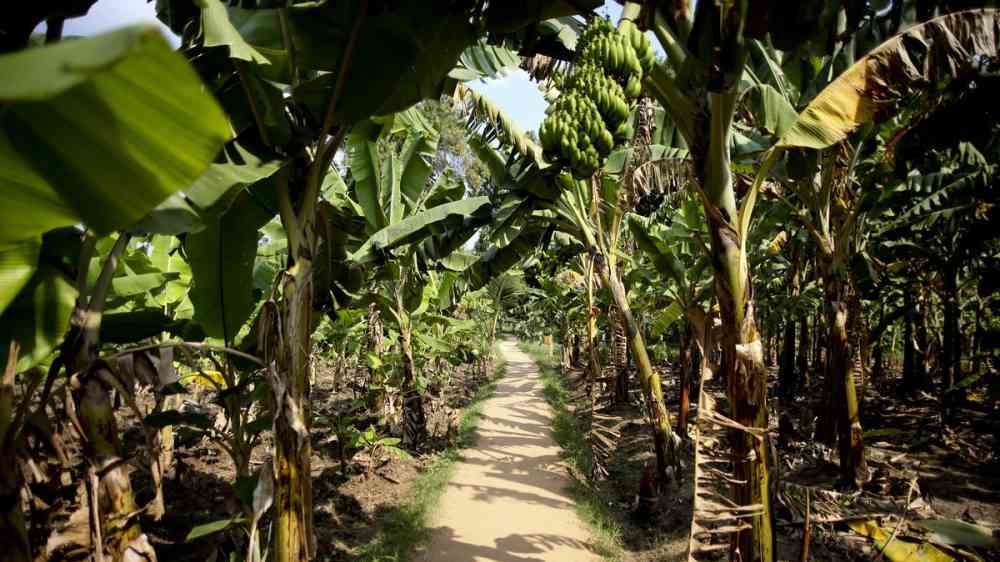‘Edible fire buffers’ could become a wildland firefighter’s best friend, study suggests

High-moisture fruit crops like bananas may become a firefighter’s strongest ally, at least in places that share the Mediterranean climate of California, as new research shows that planting buffers of high-moisture banana crops in wildland-urban interfaces can significantly slow the advance of wildfires.
Using a simulation to recreate the 150-square-kilometre Tubbs Fire that burned parts of northern California in 2017, a team of computer scientists and soil scientists found that adding a medium-sized banana plantation as a buffer zone in the wildland-urban interface (WUI) reduced fireline intensity by 96%, delaying the fire’s arrival in an urban environment by more than five hours. (The WUI is the area where houses are in or near wildland vegetation; fireline intensity is a measure of the rate at which a fire front advances, based on heat release per unit of time per unit of fire line.)
“As the time and intensity of the fire are two of the key determinants of the ability of fire crews to stop a fire, this would have a major practical impact on the protection of communities,” the team reports in the open access journal PNAS Nexus.
Depending on the size of the buffer, bananas can perform as well as a prescribed burn, understood to be the best fuel treatment.
“While under climate change the fire spreads faster, we find banana fire buffers continue to have a substantial protective benefit,” the team writes.
Knowing that global heating also threatens global food production, the team measured the productivity and profits of “edible fire buffers,” finding that banana plantations could produce a profit of US$56,000 per hectare through fruit sales, while helping to reduce the cost of firefighting and the catastrophic damage that fires inflict—$70 to $300 billion per year in the U.S. alone, the authors say.
Banana plants work so well as fire buffers due to their very high-water content: “from 93 to 99% in good moisture conditions to 76 to 88% under drought,” the researchers say. Banana buffers “largely remain intact even when affected by fire, as the banana pseudostems themselves are largely non-flammable,” they add. “Even if damaged by fire, after removal the plant will resprout from the corm,” though plants and irrigation systems may need to be replaced after an extensive fire.
The need for something akin to banana buffers is growing in western U.S., where wildfires nearly doubled in frequency between 1984 and 2015, even as the WUI increased by more than 40%. More than four million homes in California are now considered to be at major wildfire risk due to their proximity to wildland vegetation. In Canada, 12.3% of the population and 32.1% of on-reserve First Nations live in the WRI, according to an April, 2021 paper in the Canadian Journal of Forest Research.
Drought-prone places like California could use recycled water infrastructure to keep their banana buffers lush, suggest the Nexus PNAS authors, noting the “ubiquity” of recycled water in many high-fire-risk WUIs due to ornamental landscaping.
“Maximizing the reuse of municipal water, in the form of recycled water, to grow food while also protecting those same WUI areas from fire is a virtuous cycle,” they add.
Banana buffers will work best in grassland or chaparral ecosystems, the paper says. They’re a poor fit next to dense conifer forests, due to the tendency towards crown fires that can cast embers over long distances.
The team also stressed that edible buffers ideally should not be monocultures. They propose intercrops of ginger and carob, adding that the latter “high-value, high-yield” plant “can grow without supplemental irrigation in dry-summer regions” and “may be appropriate in settings where irrigation is either unavailable or too costly.”
The authors say their specific findings can be generalized to any region that shares California’s climate, including the Mediterranean Basin and parts of Mexico, Chile, Australia, and South Africa.